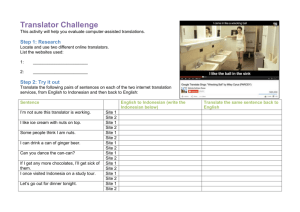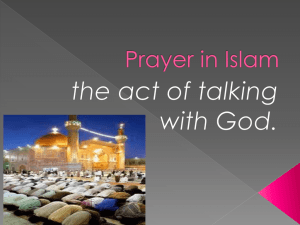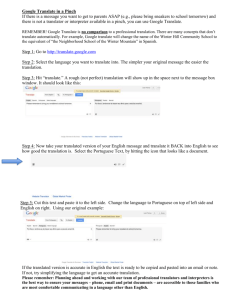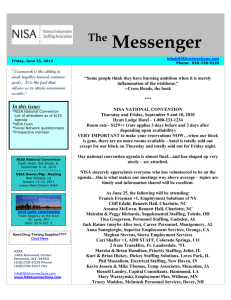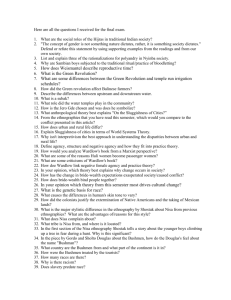File - ENGLISH for TEACHING YOUNG LEARNERS
advertisement
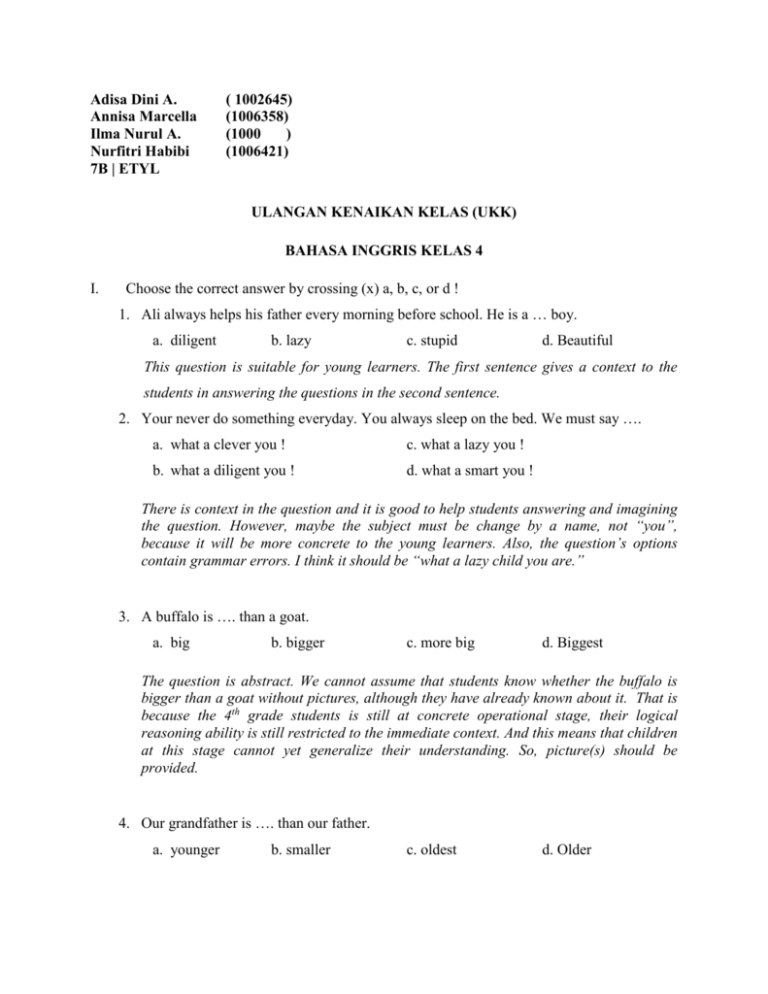
Adisa Dini A. Annisa Marcella Ilma Nurul A. Nurfitri Habibi 7B | ETYL ( 1002645) (1006358) (1000 ) (1006421) ULANGAN KENAIKAN KELAS (UKK) BAHASA INGGRIS KELAS 4 I. Choose the correct answer by crossing (x) a, b, c, or d ! 1. Ali always helps his father every morning before school. He is a … boy. a. diligent b. lazy c. stupid d. Beautiful This question is suitable for young learners. The first sentence gives a context to the students in answering the questions in the second sentence. 2. Your never do something everyday. You always sleep on the bed. We must say …. a. what a clever you ! c. what a lazy you ! b. what a diligent you ! d. what a smart you ! There is context in the question and it is good to help students answering and imagining the question. However, maybe the subject must be change by a name, not “you”, because it will be more concrete to the young learners. Also, the question’s options contain grammar errors. I think it should be “what a lazy child you are.” 3. A buffalo is …. than a goat. a. big b. bigger c. more big d. Biggest The question is abstract. We cannot assume that students know whether the buffalo is bigger than a goat without pictures, although they have already known about it. That is because the 4th grade students is still at concrete operational stage, their logical reasoning ability is still restricted to the immediate context. And this means that children at this stage cannot yet generalize their understanding. So, picture(s) should be provided. 4. Our grandfather is …. than our father. a. younger b. smaller c. oldest d. Older It is same with question number four. I think the question must be provided a context, for example picture(s), so they can generalize their understanding towards the question. 5. …… go to the cold waterfall ! a. may b. will c. let’s d. Could The question is not contextual for 4th grade students. Maybe it can be more contextual if there is a story before the question, like this, “Tina wants to go to waterfall, so she asks Ami to go to the waterfall. Tina says to Ami, “……. Go to the cold waterfall!” 6. There are tourists …. in the beach. a. drink b. eat c. read d. Swim Again, this question is not contextual. Tourists can do many things in the beach. I suggest the question must be provided by picture of what the tourists do in the beach. Do not take for granted and assume that students know the answer without a clear context. 7. “all right” in Indonesian is … a. yakinlah b. baiklah c. tentu d. Maaf Maybe a dialogue or a story should be provided in this question, so the students can elicit the meaning of the word by looking at the context given. 8. Don’t hunt animals in the …. ! a. sea b. lake c. river d. Forest Hunting animals can be done in places provided in the question’s options. So, in order to make students understand what the question means, picture or story must be provided there. 9. A : here are some bread for you ! B : ….. a. you’re welcome c. of course b. all right d. thank you This question has several correct answers. To avoid misunderstanding from the students, the question and options might be changed to this: A: here are some bread for you. B: …………… A: you are welcome. a. No, I am full. b. Yes, thank you. c. No, I am not hungry. d. Yes, you are welcome. 10. There are orange juice, coffe, ice tea in the … a. canteen b. school c. room d. Mosque Same with other questions above, all of the options can be the answer of thi question. Thus, picture must be provided here to contextualize the question and to make sure that the students understand the question. 13. A place is for studying the student is named …. b. the school b. the hospital c. the market d. the hall The question above is grammatically incorrect, so it will confuse the students to answer and will give the bad effects for the students in learning English. The question above would be better if it is changed as t follow: 13. A place where the students study is called …….. (tambahin gambar sekolah) a. the school b. the hospital c. the market d. the hall Inserting picture in the question will give the clear idea that the answer is school, so the students won’t get confused. 14. We perform prayer in the …. a. hall b. supermarket c. mosque d. clinic The question number 14 does not have a context. It is also not logic because it has a possibility that some students’ religion is not Muslim. Their religion might be Hindu, Buddha, or Christian in which the place for praying is not mosque. Thus, it is important to give the context and make the question more logical. The question above would be better if it is changed as follow: 14. Ani is Muslim. When Muslim people celebrate Idul Fitri, She and her family and other Muslims people always pray in the place called …… a. church b. Wihara c. mosque d. Pura the changing of the option will make the questions more challenging in which the students should know or have a knowledge where the place of each religion pray. 15. Could you show me …. The museum is ? a. what b. when c. who d. where the question number 15 does not have context. Context is very important because it gives information to the students where and when they will use the expression or language feature taught by the teacher. The question above would be better if it is changed as follow : 15. Dino gets lost. She wants to go to the museum, so he asks somebody, “ could you show me …….. the museum is?” a. what 16. b. when The library c. who is d. where beside the Perpustakaan ada ….. sekolah. a. didalam b. disamping c. dibelakang d. diatas school. We think, the question number 16 wants to test the students about prepositions. We think that question is quite good but it is better not to translate it into Bahasa Indonesia. By providing pictures, it seems better than it. As an alternative, the question can be changed as follow: 16. The library in SDN Sukajadi is beside headmaster room. Which picture can describe the above sentence. a. b. Library Headmaster‘s room 17. 07.15 It is ….. past seven a. a half 18. b. a quarter c. ten d. seven 07.00 The studying English will begin at seven … a. A half 19. c. o’clock b. a quarter d. past 08.30 The student do sport at a half …. Eight. a. o’clock b. to c. a half d. past The questions number 17, 18, and 19 ask about time. For question number 17, teacher does not give the context to the question, so we change the questions by giving the context to this question as the follow: 17. Rani is late, she comes to school at 07.15. What time does Rani come to school? a. a half past seven b. a quarter past seven c. a quarter to seven d. a half to seven Teacher cannot abruptly make a question without giving context to indirectly explain to the students when using the expression. Logically, to utter this expression there should be an external initiation in form of questions or situation given. For question number 18 and 19, the teacher has given the context through these questions, yet there are some points to be highlighted. In question number 18, the usage of “the” is inappropriate. It would be better if question 18 is changed as follow: 18. English class will begin at 07.00 What time English class will begin? a. Seven o’clock b. seven to nine c seven past nine d. seven to ten then for the question number 19,there is grammatical error, “student” in this question is singular noun, so the verb following the singular noun is singular verb (does), yet in this question the verb following the singular noun is plural verb (do). So, the question should be as follow: 19. Students do sport at 08.00 What time do students do sport? a. a half past eight b. a quarter past eight c. a quarter to eight d. a half to eight In term of choices, it should be better if the degree of every choice is equal, or the choices should be similar, so, we change the choices for questions number 17, 18, and 19. 20. Nisa biasanya makan siang di rumah. Nisa …… has lunch in the house. a. always b. seldom c. usually d. rarely The question number 20 is aimed to ask about frequency. I think, this question would be better if using full English rather than translate it from Indonesia to English. It is because, the students will confuse when the context is in English. The questions would be better if it is changed as follow: 20. Nisa has lunch in the house every day. It mean Nisa……………has lunch in the house. a. always b. seldom c. usually d. Rarely It is …. 1994 21. c. nineteen ninety four d. nineteen ninety six c. nineteen ninety four d. nineteen ninety nine This question doesn’t provide any context for the students to relate the questions with their life. As a question for 4th grade students that are in not yet come into the abstract thinking stage, a contextualized test item is very important to help them picture the question. For this question it would be better if the teacher write, for example: My sister was born in 1994. 1994 is … th 11. July 4 a. the first I was born on July …. b. the second c. the third d. the fourth I consider this question as a better question than the previous number because it provides context related to students life. 12. A ….. is for boiling water. a. frying pan b. napkin c. pan d. Spoon Again, this item doesn’t provides context or picture to help the 4th grade students answer the question. There are also two choices that might cause confusions to the Ss in answer the question. A. frying pan c. pan. Without a picture it is possible for the Ss to choose A. fryingpan because we know that in Indonesian context, sometimes frying pan also used to boil water to cook instant noodle. 13. A baby likes to drink a … of milk. a. spoon b. glass c. fork d. Plate This item provides context for the Ss. It is good to help them imagine the situation. One thing to consider is the answer. It is stated that a baby likes to drink a … of milk. The answer expected is b. glass, but we knew that normally, baby drinks milk from bottle. So, I think that again, a picture is important. 14. The colour of jasmine is ….. a. white b. blue c. orange d. pink Along with other questions in this sheet, it has no context for the Ss although we knew that jasmine’s colour is white. II. Fill the blanks correctly! 1. You can speak English clearly. We can say : what a ….. you ! The previous section has stated that to answer this kind of question or to response to this expressions the right expression is “what a … you are!” 2. Borobudur ….. is located in Magelang. For this question, I think that providing a short story or explanation about Borobudur temple would be better for the Ss. 3. Kuta beach is very …. This question will cause confusion to the Ss, it has various possible answer such as, kuta beach is very wide, kuta beach is very crowded, kuta beach is very far or kuta beach is very beautiful. Again, ambiguous item isn’t reliable to used to measure Ss ability. Try to use a picture to make the question more focus and helps students to give appropriate answers. 4. A : this cake is for you. B : thank you. A : ….. I think this item is good enough, it provides context. It also guides Ss to answer “you’re welcome” to response “thank you”. A clear step in question helps students to create appropriate response toward the question. 5. We buy donuts in the …. For this question a lot of possible answers will occur from the Ss because we can buy donuts everywhere, in the bakery, in the market, in the canteen or another place. Various answers will influence the scoring. III. Fill the blanks correctly! IV. We buy donuts in the …. V. A doctor works in the ….. VI. VII. It is ….. 2007 VIII. August IX. It is … past nine. 09.30 1 st It is …. My father needs a … rice. We think the content of the questions isn’t clear, and we think the questions aren’t appropriate. We can see that the question just asks the students to do the questions directly without giving an example. Yes, it would be better if we give an example. Every student has their own ability, how come with the students has lower ability and didn’t understand the instruction. Before we make a task or exercise, it would be better if we think the reliability of the content, the objective and we have to think the student can do this task or not. III. Answer the question! Translate into English ! 1. Mari kita pergi ke laut. 2. Maukah kamu tunjukkan padaku dimana pasar itu ? 3. Pukul 11.15. Translate into Indonesian ! 4. I like sun flower. 5. A napkin is for drying hand Here, we think that the exercise is not appropriate, we can see into the content. Here the students should do the exercise, but it is not appropriate and just said “translate into English and translate into Indonesian”. It would be better if we make clear instruction and give an example to make student easy to understand. Here we think that the exercise it would be better: III. Answer the questions below number 1 to 3 translate the sentences into English. Here the example is: Saya suka buah apel. I like apple. 1. Mari kita pergi ke laut. 2. Maukah kamu tunjukkan padaku dimana pasar itu ? 3. Pukul 11.15. And here for number 4 and 5 translate the sentences into Indonesian. Here the example is: I like apple. Saya suka buah apel. 4. I like sun flower. A napkin is for drying hand. Overall analysis It seems that the test made for fourth grade is not the good one. There are many mistakes in three components of good test for young learner, which are Context, grammatical structure, and logical. The first mistake is at context. Mostly, the test does not have context in which context is very important to give the students information where and when they have to use the expressions or language features taught by the teacher. Second mistake is at grammatical structure. There are some questions that the structure is unwellform. For example, 13. A place is for studying the student is named …. a. the school b. the hospital c. the market d. the hall The question above is grammatically incorrect, so it will confuse the students to answer and the grammatical mistake will give bad effect to the students, such as fossilization. The question above would be better if it is changed as t follow: 13. A place where the students study is called …….. (tambahin gambar sekolah) a. the school b. the hospital c. the market d. the hall Inserting picture in the question will give the clear idea that the answer is school, so the students will not get confused. The third mistake is at the logical elements. When developing or creating a test, we should consider this thing because when young learners finding the illogical questions, especially at the option, they would be confuse to answer because all of the options provided might be true for them, or might be false for them . For example, 14. We perform prayer in the …. a. hall b. supermarket c. mosque d. clinic beside the question above does not have a context. It is also not logic because it has a possibility that some students’ religion is not Muslim. Their religion might be Hindu, Buddha, or Christian in which the place for praying is not mosque. Thus, it is important to give the context and make the question more logical. The question above would be better if it is changed as follow: 14. Ani is Muslim. When Muslim people celebrate Idul Fitri, She and her family and other Muslims people always pray in the place called …… a. church b. Wihara c. mosque d. Pura The changing of the option will make the questions more challenging in which the students should know or have a knowledge where the place of each religion pray. In addition, creating a question in order to check the student understanding about particular subject, such as preposition or frequency by translating into Bahasa Indonesia is not good enough for the students because they are not used to using it in English so the students will confuse when the context in English. For example for the question number 20: 20. Nisa biasanya makan siang di rumah. Nisa …… has lunch in the house. a. always b. seldom c. usually d. rarely The question number 20 is aimed to ask about frequency. I think, this question would be better if using full English rather than translate it from Indonesia to English. The questions would be better if it is changed as follow: 20. Nisa has lunch in the house every day. It mean Nisa……………has lunch in the house. a. always b. seldom c. usually d. rarely
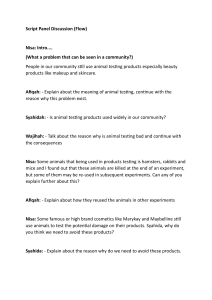
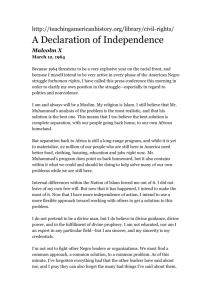

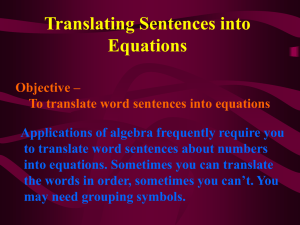
![PERSONAL COMPUTERS CMPE 3 [Class # 20524]](http://s2.studylib.net/store/data/005319327_1-bc28b45eaf5c481cf19c91f412881c12-300x300.png)
